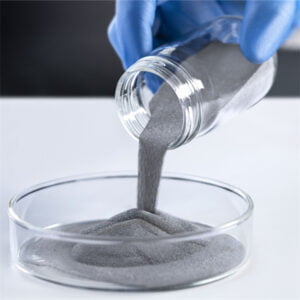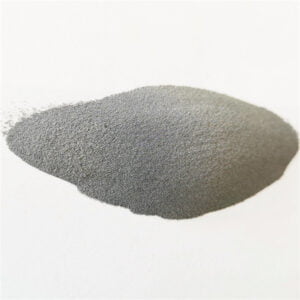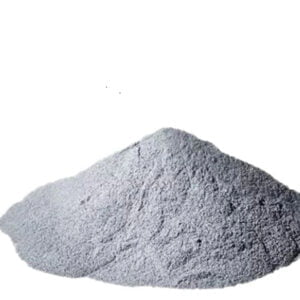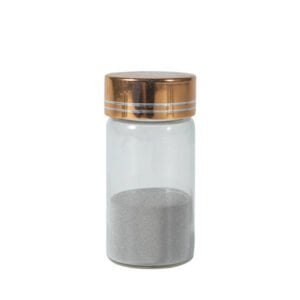
410L Powder: Superior Strength and Versatility in One Alloy
Low MOQ
Provide low minimum order quantity to meet different needs.
OEM & ODM
Provide customized products and design services to meet unique customer needs.
Adequate Stock
Ensure fast order processing and provide reliable and efficient service.
Customer Satisfaction
Provide high quality products with customer satisfaction at the core.
share this article
Table of Contents
When you’re working in industries where durability, corrosion resistance, and heat tolerance are critical, you need materials that perform under pressure. One such material is 410L powder, a low-carbon martensitic stainless steel that offers a unique blend of strength, corrosion resistance, and machinability. Whether you’re using it for additive manufacturing, powder metallurgy, or traditional fabrication methods, 410L powder is a versatile option that holds up in numerous applications.
In this comprehensive guide, we’ll dive into everything you need to know about 410L powder. From its composition and mechanical properties to its applications, pricing, and how it compares to other materials, you’ll find all the details you need to determine if 410L powder is the right fit for your project. Let’s get started!
Overview
410L powder is a low-carbon version of 410 stainless steel, known for its excellent corrosion resistance and high strength. The L in 410L stands for “low carbon,” which helps to improve the material’s weldability and formability without sacrificing its mechanical strength. This material is often used in powder metallurgy and additive manufacturing, as it can be easily processed into complex shapes while maintaining its core properties.
Here are some key points to remember about 410L powder:
- Corrosion resistance: While not as corrosion-resistant as some austenitic grades like 316L, 410L offers adequate protection in mildly corrosive environments.
- Strength: Known for its high hardness and tensile strength, this material is ideal for applications requiring wear resistance and structural integrity.
- Heat resistance: 410L performs well in high-temperature environments, making it suitable for thermal processing and heat-treating equipment.
- Cost-effective: Compared to other stainless steels, 410L is relatively affordable, making it a good choice for industries with tight budgets.
Composition and Properties
Let’s dive into the chemical composition and mechanical properties that make 410L powder such a popular choice for various industrial applications. Understanding what’s inside 410L powder helps to clarify why it performs the way it does.
Chemical Composition
The chemical composition of 410L powder is what gives it its unique characteristics. Below is a table that breaks down the key elements in 410L powder and their respective roles.
| Element | Percentage (%) | Role in the Alloy |
|---|---|---|
| Iron (Fe) | Balance | Provides the structural backbone of the alloy. |
| Chromium (Cr) | 11.5 – 13.5% | Improves corrosion resistance and adds to the alloy’s hardness. |
| Carbon (C) | Max 0.03% | Low carbon content helps to improve weldability and reduce brittleness. |
| Manganese (Mn) | Max 1.0% | Enhances strength and ductility, aiding in the forming process. |
| Silicon (Si) | Max 1.0% | Improves the material’s oxidation resistance at high temperatures. |
| Phosphorus (P) | Max 0.04% | Kept low to maintain ductility and prevent brittleness. |
| Sulfur (S) | Max 0.03% | Improves machinability without compromising the material’s integrity. |
Mechanical Properties
Mechanical properties are essential when choosing any material for high-performance applications. Here’s a breakdown of 410L powder’s key mechanical attributes:
| Property | Value | Explanation |
|---|---|---|
| Density | 7.7 g/cm³ | High density contributes to the material’s strength and durability. |
| Tensile Strength | 440 MPa | Provides good mechanical strength for structural applications. |
| Yield Strength | 275 MPa | Sufficient yield strength for applications requiring high loads. |
| Elongation at Break | 20% | High ductility, making it suitable for forming and shaping. |
| Hardness (Brinell) | 180 HB | Moderate hardness, ensuring good wear resistance and longevity. |
| Melting Point | 1,480°C | Suitable for high-temperature environments where heat resistance is necessary. |
| Corrosion Resistance | Moderate | Performs well in mildly corrosive environments, but not ideal for extreme corrosive conditions. |
| Thermal Conductivity | 24.5 W/m·K | Offers decent thermal conductivity for heat transfer applications. |
These properties make 410L powder an excellent choice for industries that require a balance of strength, corrosion resistance, and heat tolerance. While it may not have the highest corrosion resistance (as compared to austenitic stainless steels), its wear resistance and mechanical performance make it a versatile material.
Applications
Because of its versatile characteristics, 410L powder finds use in a wide range of industries. From automotive to aerospace, oil and gas to medical equipment, this material can meet the demands of many different environments.
Common Applications
| Industry | Application | Why 410L is Used |
|---|---|---|
| Automotive | Brake components, gears, and exhaust systems | High wear resistance and good heat tolerance. |
| Aerospace | Turbine blades, engine components | Capable of withstanding high temperatures and mechanical stress. |
| Medical Devices | Surgical instruments, dental tools | Offers a balance of corrosion resistance and strength. |
| Oil and Gas | Pumps, valves, downhole tools | Performs well in moderate-corrosion environments with wear resistance. |
| Additive Manufacturing | Custom components for high-stress applications | Powder form allows for precision manufacturing and complex geometries. |
Automotive Applications
In the automotive industry, 410L powder is frequently used in the production of brake components, gears, and exhaust systems. Its high wear resistance ensures that these parts can withstand the friction and mechanical stress they face daily. Additionally, its heat resistance makes it ideal for use in areas exposed to high temperatures, such as engines and exhaust systems.
Medical Applications
For medical devices, 410L powder is an excellent choice due to its biocompatibility and corrosion resistance. Surgical tools and dental instruments benefit from the alloy’s strength and ability to resist rusting in sterilization processes, making it a reliable material for critical medical applications.
Specifications, Sizes, and Standards
Before selecting 410L powder, it’s crucial to understand the specifications, sizes, and standards that apply. These factors can influence how well the material performs for your specific application.
Common Specifications, Sizes, and Standards
| Specification | Details |
|---|---|
| Particle Size | 15 to 150 microns, depending on the application. |
| Purity | Typically 99.5%+ purity for industrial applications. |
| ISO Certification | Available with ISO 9001 and ISO 13485 for medical and industrial use. |
| ASTM Standards | ASTM A240, ASTM A276 for stainless steel applications. |
| Form | Available as powder, bars, rods, and sheets. |
The particle size of 410L powder can vary depending on its intended use. Fine powders are ideal for additive manufacturing and powder metallurgy, while coarser powders are more suitable for welding and traditional fabrication methods. Additionally, the material is available in various forms, including bars, rods, and sheets.
Suppliers and Pricing
The price of 410L powder can vary depending on factors such as particle size, purity, and the supplier. Pricing is also influenced by market demand, geographical location, and production methods.
Popular 410L Powder Suppliers and Pricing Details
| Supplier | Price Range (per kg) | Notes |
|---|---|---|
| Sandvik Materials Technology | $40 – $120 | Known for high-quality stainless steel powders for industrial applications. |
| Carpenter Technology | $45 – $140 | Specializes in high-purity powders for additive manufacturing. |
| Höganäs AB | $35 – $110 | Offers a wide range of particle sizes for various applications. |
| LPW Technology | $50 – $150 | Recognized for high-performance powders used in 3D printing. |
Factors Influencing Pricing
Several factors influence the pricing of 410L powder, including:
- Purity: Higher-purity powders are typically more expensive, especially those used in medical or aerospace applications.
- Particle Size: Finer powders used in additive manufacturing tend to cost more due to the precision required in the production process.
- Supplier Reputation: Well-established suppliers with strict quality control can charge more, but they offer greater reliability and consistency.
Advantages and Limitations
Like all materials, 410L powder has its advantages and limitations. Understanding these can help you determine whether this material is suitable for your particular project.
Advantages
| Advantage | Why It’s Important |
|---|---|
| Good Corrosion Resistance | Performs well in mildly corrosive environments, suitable for industrial equipment. |
| High Heat Resistance | Can withstand high temperatures, making it ideal for thermal processing applications. |
| Ease of Machining | Offers good machinability for complex shapes and precision components. |
| Cost-Effective | More affordable than higher-grade stainless steels like 316L. |
Limitations
| Limitation | Why It’s a Concern |
|---|---|
| Moderate Corrosion Resistance | Not suitable for highly corrosive environments or marine applications. |
| Lower Ductility | Less ductile compared to austenitic grades, limiting its use in flexible applications. |
| Not Ideal for Cryogenic Uses | Performs poorly in low-temperature environments, as it becomes more brittle. |
Comparing 410L Powder to Other Stainless Steels
How does 410L powder compare to other commonly used stainless steels like 316L or 304L? Below, we’ll explore the strengths and weaknesses of 410L powder compared to these other materials.
410L Powder Compared to Other Stainless Steel Alloys
| Alloy | Strengths | Weaknesses |
|---|---|---|
| 410L Powder | High wear resistance and good heat tolerance. | Moderate corrosion resistance, not suitable for marine environments. |
| 316L Powder | Excellent corrosion resistance, especially in marine settings. | More expensive and lower hardness compared to 410L. |
| 304L Powder | Widely available and cost-effective. | Lacks the wear resistance of 410L and corrosion resistance of 316L. |
When to Choose 410L Over Other Alloys
- Wear Resistance: If your project requires high wear resistance and mechanical strength, 410L powder is a better choice than 304L or 316L.
- Cost Considerations: For projects where budget is a concern but you still need heat resistance and moderate corrosion protection, 410L is a great middle-ground option.
- Corrosion Resistance: If corrosion resistance is the top priority (especially in marine or chemical environments), 316L or 304L might be a better option.
Frequently Asked Questions (FAQs) About 410L Powder
FAQ Section
| Question | Answer |
|---|---|
| What is 410L powder used for? | Commonly used in automotive, aerospace, and industrial applications due to its wear resistance and heat tolerance. |
| How much does 410L powder cost? | Prices range from $35 to $150 per kg, depending on purity and particle size. |
| Can 410L powder be used for additive manufacturing? | Yes, 410L powder is commonly used in additive manufacturing for high-precision components and wear-resistant parts. |
| Is 410L powder corrosion-resistant? | While it offers moderate corrosion resistance, it is not as resistant as higher-grade stainless steels like 316L. |
| What industries use 410L powder the most? | Industries like automotive, oil and gas, aerospace, and medical devices frequently use 410L powder. |
| How does 410L powder compare to 316L powder? | 410L has better wear resistance and heat tolerance, but 316L offers superior corrosion resistance, especially in marine environments. |
| Can 410L powder be easily welded? | Yes, its low carbon content improves weldability, reducing the risk of cracking during the welding process. |
-
 Ti45Nb Powder for Additive Manufacturing
Ti45Nb Powder for Additive Manufacturing -
 TiNb Alloy Powder
TiNb Alloy Powder -
 TiNbZrSn Alloy Powder
TiNbZrSn Alloy Powder -
 Ti6Al4V Powder Titanium Based Metal Powder for Additive Manufacturing
Ti6Al4V Powder Titanium Based Metal Powder for Additive Manufacturing -
 CPTi Powder
CPTi Powder -
 TC18 Powder : Unlocking the Power of Titanium Carbide
TC18 Powder : Unlocking the Power of Titanium Carbide -
 TC11 Powder : A Comprehensive Guide
TC11 Powder : A Comprehensive Guide -
 TC4 ELI Powder
TC4 ELI Powder -
 Best Ti-6Al-4V powder (TC4 Powder)for additive manufacturing
Best Ti-6Al-4V powder (TC4 Powder)for additive manufacturing
Conclusion: Why 410L Powder is a Superior Choice for Wear-Resistant Applications
To wrap things up, 410L powder is an excellent material for industries that require a balance of mechanical strength, wear resistance, and heat tolerance. Whether you’re working in automotive, aerospace, or medical devices, this alloy offers a reliable solution for high-performance applications. Although it doesn’t provide the highest level of corrosion resistance, its affordability and strength make it a fantastic choice for a wide range of industrial needs.
If you’re looking for a material that can handle heat, wear, and moderate corrosion while keeping costs in check, 410L powder should be at the top of your list.
Get Latest Price
About Met3DP
Product Category
HOT SALE
CONTACT US
Any questions? Send us message now! We’ll serve your request with a whole team after receiving your message.

Metal Powders for 3D Printing and Additive Manufacturing
COMPANY
PRODUCT
cONTACT INFO
- Qingdao City, Shandong, China
- [email protected]
- [email protected]
- +86 19116340731











